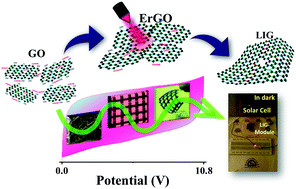Ultralong cycle life and outstanding capacitive performance of a 10.8 V metal free micro-supercapacitor with highly conducting and robust laser-irradiated graphene for an integrated storage device†
Abstract
Interconnected porous graphene plays a crucial role as supercapacitive material as well as a current collector in developing metal free microsupercapacitor (MSC) because of its unique structure and superior conductivity. Electrochemical reduction followed by use of a laser irradiation method shows advances for the fabrication of the conductive graphene-based robust device. Use of Raman spectra proves that the laser irradiation method is capable of healing the defects with fused interconnected sheets, as a result, high conductivity and improved crystallinity of the laser irradiated graphene (LIG) sample is achieved. The LIG film on a flexible substrate was patterned with the aim to develop an on-chip flexible MSC, which offers a large working voltage of 1.2 V in an aqueous solid electrolyte. Interestingly, the MSC, without any metal current collector, shows a unique electrical-double layer behavior and unprecedented cycling stability. It is worth noting that the retention of the initial capacitance after 100 000 continuous cycles was 100%. A large cell voltage of 10.8 V was realized by modularizing the array of devices without much degradation of the rectangular shapes of the voltammogram even at higher scan rates (100 V s−1). The array of LIG-MSC was integrated with a commercial solar cell module for hybrid energy harvesting and as a storage device. This study provides an effective strategy to build a metal free supercapacitor with exceptional cycle life and facilitates progress towards self-sustainable energy in the future.

- This article is part of the themed collection: #RSCPoster Conference


 Please wait while we load your content...
Please wait while we load your content...